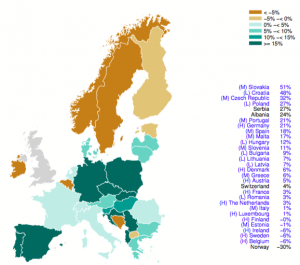More students from the EU were accepted to a UK university than ever before in 2016, the latest UCAS statistics have revealed, though experts have questioned how long this upward trajectory will continue. Meanwhile, acceptances from outside the EU have dropped for the first time in five years.
News and business analysis for Professionals in International Education
Have some pie!
UK HE: EU student acceptances up but non-EU drop
 Experts have questioned whether the upward trend in EU student applications and acceptances will continue in light of Brexit. Image: UCAS.
Experts have questioned whether the upward trend in EU student applications and acceptances will continue in light of Brexit. Image: UCAS. Acceptances from the EU have continued to climb at a steady rate for the last few years, up 7% or 2,000 students in 2016 to hit 31,400.
“Many will see it as great news that EU numbers continue to increase but the fear is whether that will continue in 2018″
They reflect an increase in both application rates – up 5.6% to 53,600 – and an increase in the proportion of those applications being accepted. A marginal increase in this rate meant 58.5% of all EU applicants were placed at universities in 2016 – the highest level since 2009.
However, the figures are being met with a degree of caution in the wake of the UK’s vote to leave the EU.
“Many will see it as great news that EU numbers continue to increase but the fear is of course whether that will continue in 2018 and thereafter if loan funding and home fees are not confirmed,” noted Dominic Scott, CEO of the UK Council for International Student Affairs.
Others are seeing the increase as a pre-Brexit rush, with students keen to enrol before the UK leaves the EU.
“The surge in EU recruitment may in time come to look like a burst of ‘buy now while stocks last’,” Nick Hillman, director of the Higher Education Policy Institute, told The Telegraph.
“For EU students, the future is likely to mean higher fees, no entitlement to student loans and tougher migration rules.”
EU students enrolling in 2017 will continue to pay the same fees as their domestic counterparts and to access student loan and grant funding for the duration of their studies, but the government has yet to confirm whether the same will apply to those beginning their studies after this point.
Application and acceptance rates have varied across the EU. Poland saw the largest hike – up 27% on last year – followed by Germany (+21%), Spain (+18%) and Bulgaria (+9%).
On the other hand, acceptances from six European countries fell. Ireland had the greatest absolute decrease, down 6% to 1,960; and Norway had the largest proportional drop, down 30% to 990.

Changes in acceptances for 2016 relative to 2015, by selected European country (with GDP per capita). Image: UCAS.
In contrast to the EU figures, non-EU student acceptances fell for the first time since 2011, down 2.3% to 38,300.
Just over half – 51.6% – of the 74,300 international students who applied were placed. Both the number of applicants and the rate of acceptances fell in 2016 – by 1.9% and 0.2% respectively.
“The acceptance rate of non-EU applicants is relatively low compared to the acceptance rates for EU and UK applicants,” the report notes.
The drop tallies with warnings from international education providers in recent years that changes to immigration regulations will likely deter international students from coming to the UK.
“This is perhaps no surprise and yet more evidence why any further restrictions as a result of the Home Office’s expected consultation [on international students] would be extremely unwise,” added Scott.
Future shifts in EU and international student numbers are likely to have a notable impact on demand for higher education in the UK in the next few years, noted outgoing UCAS CEO Mary Curnock-Cook.
In the report’s introduction, Curnock-Cook predicted that the UK’s higher education sector is entering “several years of overall flat demand for undergraduate education, driven by demographic changes in the young population in the UK, and perhaps strong headwinds for demand from the EU and international students.”
Still looking? Find by category:


